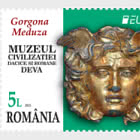Romanian Avant - Garde Writers
Romfilateliadedicates the postage stamp issue called Romanian avant-garde writers,to some outstanding representatives of the Romanian literature, whose works fall into the avant-garde movement from the beginning of the 20thcentury.
The stamps of the issue illustrate three of the Romanian writers, promoters of the avant-garde literature: Demetru Dem. Demetrescu-Buzau (Urmuz), Geo Bogza and Gellu Naum.
The avant-garde literary movements, actions that express themselves through a spirit of violent negation over established forms of art, proposing new artistic structures to the detriment of the traditional ones, that were considered obsolete, emerged in Europe at the beginning of the 20thcentury. The Romanian
avant-garde differs from the European one through its wide opening, the elimination of nihilism taken to the extreme, the synthesis of all modern artistic forms, according to its own dialectics. Of all the avant-garde movements, Dadaism, Expressionism, Futurismand Surrealismare manifested in the field of literature, the other movements being specific to fine arts.
The first avant-garde magazine in Romania was the Contimporanul (The Contemporary)led by Ion Vinea, followed by the magazines Punct (Dot), Integral (Whole), UNU (ONE) andAlge (Algae).
Demetru Dem. Demetrescu-Buzau(1883-1923), known as Urmuz, a pseudonym chosen and publicly imposed by Tudor Arghezi, is represented on the stamp with the face value of Lei 2. UNUmagazine, the most important
avant-garde publication, led by Sasa Pana, brings out the work of Urmuz, the first Romanian author who, feeling the crisis of language, promoted a literature with absurd, illogical elements, but not in the violent form of European Dadaism, but using a classical form. The writer had an unexpected contribution to the Romanian avant-garde literature. His writings, that are experiencing a posthumous fame, contributed to the expansion of aesthetic consciousness. Among these, we mention Algazy & Grummer, Cotadi and Dragomir, The Chroniclers, The Fuchsiad,IsmaďlandTurnavitu,The Funnel and Stamateetc.
Geo Bogza (1908-1993), a Romanian writer, journalist, poet, avant-garde theorist and one of Urmuz’s disciples, acted as a follower of avant-garde since his literary beginnings, assuming his own creation from the perspective of intense, authentic life experience, but also in terms of some new and real experiences. Editor of Urmuz magazine and collaborator of Bilete de papagal (Parrot Tables)and UNUmagazines, Geo Bogzaapproached the reportage, the literary genre that brought him fame. Among his reportage pieces, we mention The Book of the Olt River, Lands of Stone, Fire, Earth, Men and Coal in the Jiu Valley. The writer, member of the Romanian Academy since 1955 and awarded in 1978 with the Grand Prize of the Romanian Writers’ Union, is represented on the stamp with the face value of Lei 3.
Gellu Naum (1915-2001), poet, prose writer, playwright and translator, is represented on the stamp with the face value of Lei 19. He is considered to be the most important surrealist Romanian and one the last major representative of this current in Europe. In 1941, together with Gherasim Luca, Dolfi Trost, Virgil Teodorescu and Paul Paun, establish the Romanian surrealist group that has a particularly intense activity between 1945-1947. His work includes poetry volumes (The Incendiary Traveler, The Coridor of Sleepetc.), prose (Medium, Zenobiaetc.), theatre (The Island, Maybe Eleonoraetc.), but also children’s literature (Books with Apolodor).
His works are translated into the main international languages, while being awarded with important prizes: Special Prize of the Romanian Writers’ Union, for all his literary activity, 1986; European Poetry Prize, Münster,1999etc.
Romfilatelia thanks the National Museum of Romanian Literature, the Romanian Academy Library, Gellu Naum Foundation and Mr. Prof. Ph.D. Silviu Angelescu for the documentary and photographic support grated for the achievement of this postage stamp issue.
Romania - Recommended stamp issues
WOPA+ recommended stamp issues
| Avatar - Fire and Ash |
| Issued: 03.12.2025 |
| ›New Zealand |
| 50th Anniversary of the Founding of the 24th November Bar Scout |
| Issued: 24.11.2025 |
| ›Montenegro |
| Krisjanis Valdemars |
| Issued: 02.12.2025 |
| ›Latvia |
| Sign Language - Good |
| Issued: 02.12.2025 |
| ›Bosnia and Herzegovina - Republic of Srpska |
| In Memory of the Fallen and Murdered on October 7, 2023 |
| Issued: 08.10.2025 |
| ›Israel |
| Annual Collection Folder (New York) |
| Issued: 05.12.2025 |
| ›United Nations |
| Year Set |
| Issued: 24.11.2025 |
| ›Isle of Man |
| Shipping in the 17th and 18th Centuries - Peat Shipping |
| Issued: 05.12.2025 |
| ›Netherlands |












































